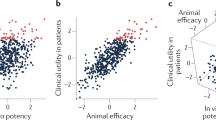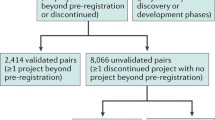Abstract
This article discusses the evolving field of pharmacogenomics, which is the science of using genomic markers to predict drug response, and how it may impact the future costs, risks and returns to pharmaceutical research and development (R&D). We uncover a number of factors and issues that are likely to influence the expected returns and, hence, the incentive to invest in new pharmaceutical R&D in tandem with the development of pharmacogenomics. Specifically, we identify how pharmacogenomics may lower the cost of drug development by shortening drug development times. Thus, pharmacogenomics may lead to an increase in a drug’s effective patent life, and may also increase the demand and adoption rate for new products. For these and other reasons, pharmacogenomics may one day enhance expected future returns to R&D, leading to higher levels of R&D investment and an increased pace of pharmaceutical innovation.
Our conclusions must be read with much caution, however, as there is considerable uncertainty as to how the area will evolve, both clinically and economically. The time horizon necessary for the science to develop and be adopted into clinical practice is not clear. Nevertheless, we think the issues and factors outlined in this article shed light on possible future economic outcomes and changes in the industry’s structure, conduct and performance. Hopefully, this will provide researchers with avenues to pursue regarding a better understanding of the economics of pharmacogenomics.

Similar content being viewed by others
Notes
A gene that transforms normal cells into cancerous cells.
The sensitivity of prescribing behaviour to the genetic marker may not be strong for trastuzumab because the drug is still reasonably effective for those who do not exhibit the HER2/neu gene. This has resulted in doctors prescribing the medication even in the absence of a genetic test.
This assumption follows the model laid out by Vernon et al.[8] While a constant linear relationship between value and price for a drug is not likely given existing prescribing and reimbursement structures, as long as the price does not fall with increases in value, the general conclusions of the model should hold.
For an industry discussion of the importance of pharmacogenomics and an adoption rate (as well as the potential for R&D savings), see The Pink Sheet.[12]
“The number of drug targets has risen from 500 to more than 5000 in recent years, and expansion of research activity to investigate them is a natural and desirable consequence. Some part of the spending increase also represents well-justified ‘retooling’ investments in new technology and development of new research capabilities that will pay off for years to come. But other spending drivers might be lowering industry productivity. Two muchdiscussed issues are ‘mining out’ and regulatory delay. Research might necessarily be becoming more expensive because the ‘low-hanging fruit’ has been already been picked: Current areas of unmet medical need are increasingly those in which diseases are more complex and more difficult to understand and control, and drug targets more difficult to attack. And notwithstanding various reforms of the funding and management of the FDA, the time and cost of obtaining regulatory approval remain sources of concern.”
The reasons why there may be a socially suboptimal level (too little) of current pharmaceutical and medical R&D are beyond the scope of this article; the interested reader is referred to the edited volume by Murphy and Topel, Measuring the Gains from Medical Research.[26]
References
Human Genome Project information [online]. Available from URL: http://www.ornl.gov/sci/techresources/Human_Genome/medicine/pharma.shtml [Accessed 2009 Apr 28]
McWilliam A, Lutter R, Nardinelli C. Healthcare impact of personalized medicine using genetic testing: an exploratory analysis for warfarin. Personal Med 2008 May; 5 (3): 281
Pollack A. Patient’s DNA may be signal to tailor medication. New York Times [online]. Available from URL: http://www.nytimes.com/2008/12/30/business/30gene.html [Accessed 2009 Apr 28]
Genentech USA, Inc. What is herceptin? [online]. Available from URL: http://www.herceptin.com/adjuvant/what-is/index.jsp [Accessed 2009 Apr 28]
Press M, Seelig SA. Lessons learned from the development of a diagnostic to predict response to herceptin: targeted medicine: from concept to clinic. Thomson Financial Street Events, 2004 [online]. Available from URL: http://www.targetedmed.com/flash/lib/pdf/Targeted%20Medicine%20Report.pdf pp. 9–10 [Accessed 2009 Apr 28]
Personalized medicine – today! Clinical Ligand Assay Society; 32nd International Meeting; 2006 May 22; Louisville (KY). Slide 23 [online]. Available from URL: http://www.fda.gov/cder/genomics/presentations/CLAS.pdf [Accessed 2009 Apr 28]
DiMasi J, Hansen R, Grabowski G. The price of innovation: new estimates of drug development costs. J Health Econ 2003; 22: 151–85
Vernon JA, Johnson S, Hughen WK, et al. Economic and development considerations for pharmacogenomics technology. Pharmacoeconomics 2006; 24 (5): 335–43
Haley S. Personalized medicine not a threat to blockbuster model: Lilly President Lechleiter. Pink Sheet Daily 2007 Nov 30; 007
Spears B, Heath-Chiozzi M, Huff J. Clinical application of pharmacogenetics. Trends Mol Med 2001 May; 7 (5): 201–4
Phillips KA, Veenstra DL, Oren E, et al. Potential role of pharmacogenomics in reducing adverse drug reactions: a systematic review. JAMA 2001 Nov 14; 286 (18): 2270–9
Better, faster, smaller: personalized medicine could bring R&D savings. Pink Sheet 2008 Mar 3; 70 (9): 24
Ingelman-Sundberg M. Pharmacogenomic biomarkers for prediction of severe adverse drug reactions. N Engl J Med 2008 Feb 7; 358 (6): 637–9
Berenson A. Pfizer ends studies on drug for heart disease. New York Times 2006 Dec 3 [online]. Available from URL: http://www.nytimes.com/2006/12/03/health/03pfizer.html [Accessed 2009 Apr 28]
Editorial: looking forward, looking back. Nature Biotechnology 2008 May (corrected 2008 June 13); 26 (5): 475 [online]. Available from URL: http://www.nature.com/nbt/journal/v26/n5/pdf/nbt0508-475.pdf [Accessed 2009 Apr 28]
GSK, Merck KGaA agree to end joint Vilazodone development. Apr 17, 2003 [online]. Available from URL: http://www.lexdon.com/article/gsk_merck_kgaa_agree_to/125249.html [Accessed 2009 Apr 27]
Clinical Data. Clinical Data delivers Vilazodone milestone payment to Merck KGaA. Dec10, 2007 [online]. Available from URL: http://investor.clda.com/releasedetail.cfm?ReleaseID=280467 [Accessed 2009 Apr 27]
BioPharma Today [online]. Available from URL: http://www.biopharmatoday.com/2008/09/arca-files-nda.html# more [Accessed 2008 Sep 30]
Winslow R. Gene analysis boosts sidelined heart drug. Wall Street J 2008 Sep 23; D2 [online]. Available from URL: http://online.wsj.com/article/SB122212399407465005.html [Accessed 2009 Apr 28]
DiMasi JA, Grabowski HG. Managerial and decision economics. 28. West Sussex: John Wiley & Sons Ltd, 2007: 469–79
Cockburn IM. The changing structure of the pharmaceutical industry [online]. Available from URL: http://content.healthaffairs.org/cgi/reprint/23/1/10.pdf [Accessed 2009 Apr 28]
Vernon JA. Examining the link between price regulation and pharmaceutical R&D investment. Health Econ 2005; 14 (1): 1–16
Giaccotto C, Santerre R, Vernon JA. Pricing and R&D investment behavior in the pharmaceutical industry. J Law Econ 2005; 48: 195–207
Lichtenberg FR. Sources of U.S. longevity increase, 1960–1997. Cambridge (MA): NBER working paper 8755, 2002 Feb
Cutler DM, McClellan M. Is technological change in medicine worth it? Health Affairs 2001 Sep/Oct; 20 (5): 11–29
Murphy KM, Topel RH. Measuring the gains from medical research: an economic approach. In: Murphy KM, Topel RH, editors. Chicago (IL): University of Chicago Press, 2003
Acknowledgements
The authors are very grateful to a number of individuals for helpful comments and suggestions regarding this research: Ernie Berndt, W. Keener Hughen, Gary Persinger and Kimberly Westrich. The authors gratefully acknowledge the support of the National Pharmaceutical Council for funding this work. The funding was to support independent research and no agreement was formed as to the conclusions contained in the paper.
Author information
Authors and Affiliations
Corresponding author
Rights and permissions
About this article
Cite this article
Cook, J., Hunter, G. & Vernon, J.A. The Future Costs, Risks and Rewards of Drug Development. Pharmacoeconomics 27, 355–363 (2009). https://doi.org/10.2165/00019053-200927050-00001
Published:
Issue Date:
DOI: https://doi.org/10.2165/00019053-200927050-00001




